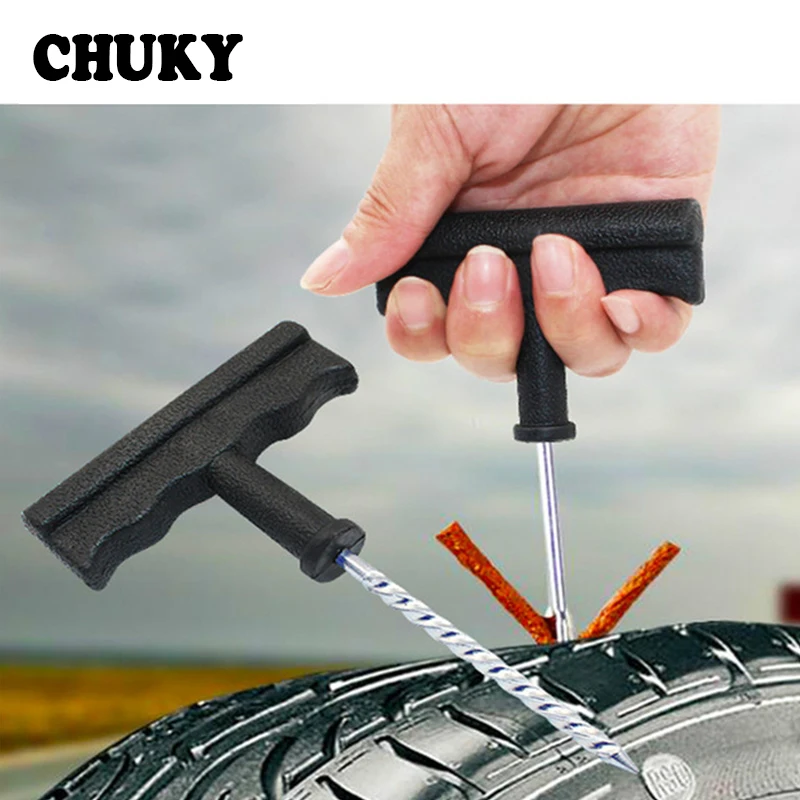(Image credit: Danielle Tarloff // Future)
No one wants to be the rider who has to end a ride early. Tubeless plug tools are a small item that can make the difference between getting in the miles and limping home. Gravel cycling’s growth to a major discipline over the last few years has brought with it a range of tire sizes, treads, and setups, with tubeless as the expectation for anything larger than 28mm wide. Traveling along back roads, ranch routes, rail trails, and other less-trafficked paths have been the main appeal of getting off the tarmac. These mixed surfaces are not without their hazards and nails, staples, sharp rocks, and other debris can bring a swift interruption to the gravel cyclists’ ride.
Tubeless sealant works magic on many small punctures, but losing a substantial portion of sealant puts the rider at greater risk down the trail. For larger holes or ones that don’t seem to be sealing quickly, tubeless repair tools are incredibly handy and have become essential items in the gravel riders’ repair kit.
Most of these function on the same principle, a two-pronged fork holds a rubbery strip that is inserted to plug the hole in the tire. There is a range of associated accessories, strip sizes, and carrying methods. Some of these are built into robust tool systems, designed to replace the traditional multi-tool, while others are stealthily hidden into handlebars, or stashed with the rest of the repair kit. For most, the goal is to rapidly plug the hole losing as little sealant and tire pressure as possible.
(Image credit: Danielle Tarloff // Future)
While the traditional flat kit of tire levers, tube, pump (or CO2 inflator) and multitool is the core basic you should have on every ride, the addition of a tubeless plugger can make the difference whether or not you need to use those resources. To find the right plug tool for you, consider a few variables:
Storage - Ease of access to this tool can make the difference between losing a few PSI or leaking sealant all over the road.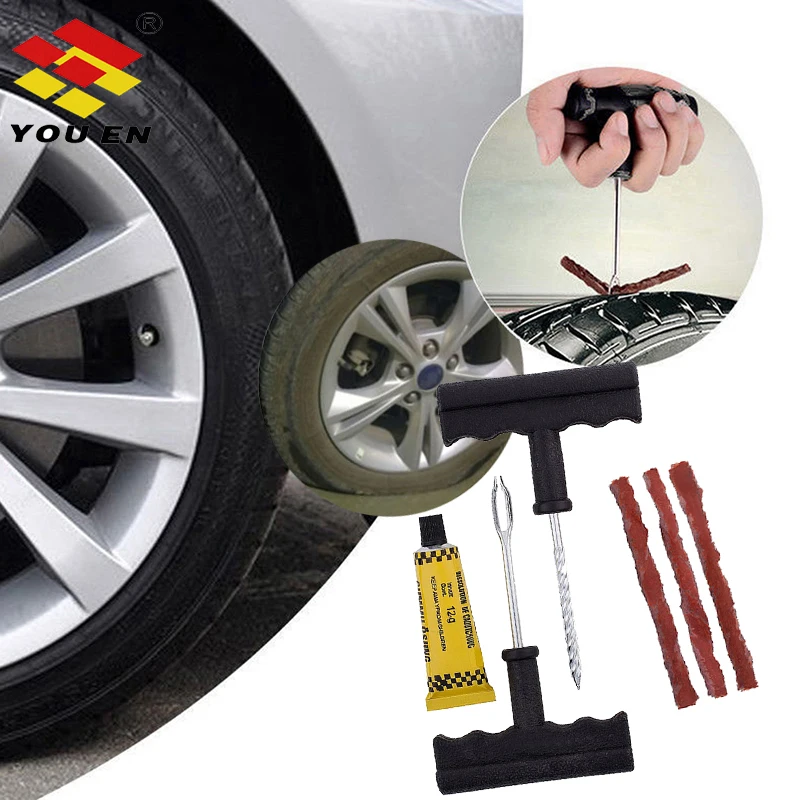 Many products are designed to be stored in a handlebar so they take up minimal space. Others strap onto your bike, and some are small enough to be added into your exiting flat kit or tool wrap.
Many products are designed to be stored in a handlebar so they take up minimal space. Others strap onto your bike, and some are small enough to be added into your exiting flat kit or tool wrap.
Multi-taskers - Many of the best plugger tools we tested were built to do that one thing, while others are built into multi-tools or entire tool systems. Are you happy with your existing multi-tool or other elements of your flat kit? If not then consider these multi-taskers as a clever way to build out your tool arsenal.
Type of riding - This test was structured with gravel riding and the tires and likely punctures of this style of riding. Many of the pluggers in the market are oriented to mountain biking and size their tools and repair strips accordingly. We struggled with this larger strip size and left off several tools that fell into this category. Additionally, the kit you carry may vary depending on pace, terrain, and remoteness. Some tools are oriented toward fast and light, while others are heavier duty or feature-rich.
Below is our round-up of plug tools, our favorites as well as the ones that we tested but missed the mark.
With each tool is a ‘Buy Now’ or ‘Best Deal’ link. If you click on this then we may receive a small amount of money from the retailer when you purchase the item. This doesn’t affect the amount you pay.
(Image credit: Danielle Tarloff // Future)
The Best Overall Plug Kit
Plug strips included?: Yes
Attached to or integrated into the bike?: Yes, comes with a frame strap
+
Reliable and easy to use.
+
Comes with 10 plug strips.
+
Durable hook and loop strap attaches anywhere.
+
Great value.
-
A bit bulky perhaps
Today's Best Deals
The Plugger kit from Blackburn does one job and it does it quickly and reliably. The plastic housing feels lightweight but durable and contains the tool and ten plug strips. It allows the plugger to be preloaded, allowing for fast deployment. A quick turn releases the tool from the housing, which is a metal tube with an open and pointed end, rather than the frequently seen fork. This difference was a benefit as strips always stayed in the tire and were easy to insert and load.
The plastic housing feels lightweight but durable and contains the tool and ten plug strips. It allows the plugger to be preloaded, allowing for fast deployment. A quick turn releases the tool from the housing, which is a metal tube with an open and pointed end, rather than the frequently seen fork. This difference was a benefit as strips always stayed in the tire and were easy to insert and load.
The wider diameter of the system can be a bit tricky to insert in a smaller puncture, but those would likely seal up with sealant alone. The manual encourages loading “up to two plugs at once” for larger holes and the tube was fairly easy to load with one or two stips. Two plugs were nearly enough to seal a larger (8mm) sidewall tear, but we might not trust that as a long-term fix. The Plugger kit comes with a hook and loop strap that enables fast access by strapping the kit to the bike’s frame, fork leg, or zip tied anywhere as well. We thought strapping it to our travel
pump was rather clever. Blackburn claims repairs are permanent so you can ride easy knowing that your tire should last.
Blackburn claims repairs are permanent so you can ride easy knowing that your tire should last.
USD MSRP $25.00
(Image credit: Danielle Tarloff // Future)
The Best Gravel Racing Plug Kit
Plug strips included?: Yes
Attached to or integrated into the bike?: No
+
Reliable and easy to use
+
Small and lightweight.
-
More expensive than other options.
-
Expensive proprietary refill plugs
Today's Best Deals
With origins in motorcycle tire repairs, Dynaplugs are fast, reliable, and beautifully machined tools. The slick aluminum housing of the Racer Pro contains “Twin Tube™ technology” so that it holds four ready-to-go plugs, including one Megaplug (3 times the thickness of their standard plug). Unlike the more common strips, these plugs are metal tipped to enable low-force insertion, making repair fast and easy. This also helps reduce the risk of nicking rim tape or nice carbon rims. This system takes seconds to insert into a puncture, with more plugs ready to go if needed for larger holes. This is a go-to choice when every second counts on a racecourse. For a bit of cost savings, the Racer holds two plugs, compared to the Racer Pro’s four. Dynaplug also claims repairs are permanent for the life of the tire.
Unlike the more common strips, these plugs are metal tipped to enable low-force insertion, making repair fast and easy. This also helps reduce the risk of nicking rim tape or nice carbon rims. This system takes seconds to insert into a puncture, with more plugs ready to go if needed for larger holes. This is a go-to choice when every second counts on a racecourse. For a bit of cost savings, the Racer holds two plugs, compared to the Racer Pro’s four. Dynaplug also claims repairs are permanent for the life of the tire.
USD MSRP $54.99
(Image credit: Danielle Tarloff // Future)
The Best Stealth Plug Kit - Multi Tool Combo
Plug strips included?: Yes
Attached to or integrated into the bike?: Yes
+
Stores in handlebar or existing Wolf Tooth tool
+
Highly functional tool
+
Full-featured multi-tool system
-
Expensive
-
Full-featured multi-tool system.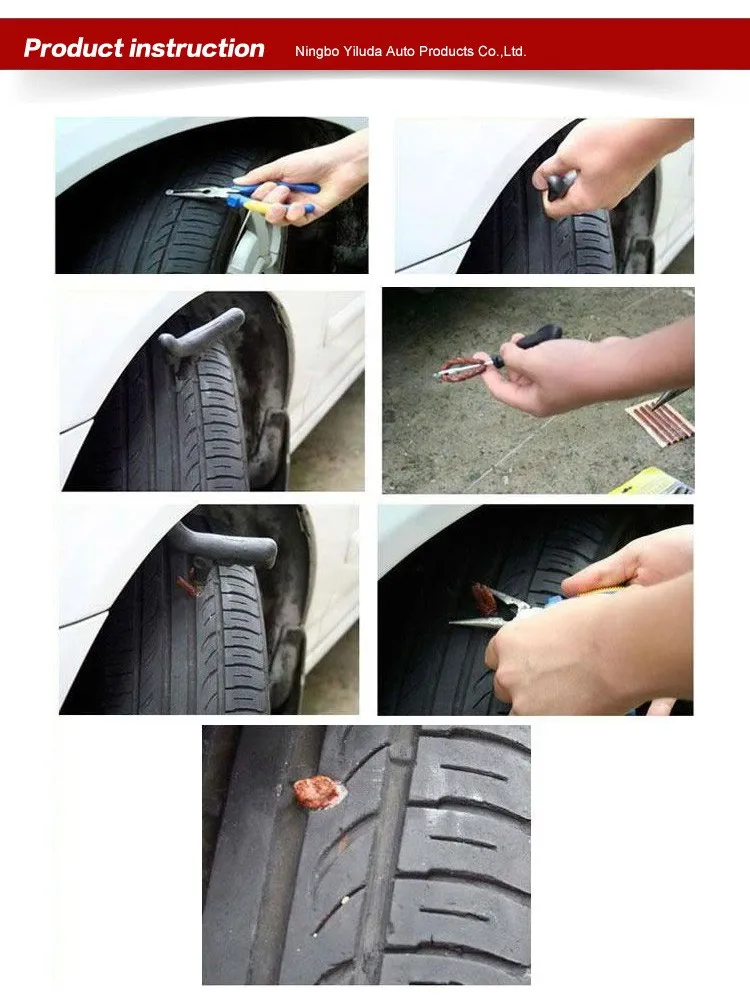
Today's Best Deals
The Wolf Tooth Encase Chain + Tire Plug Multi-Tool is meant to be a multi-tasker, but it’s a clever one at that. Initially, the kit seemed too large to fit in the curve of a drop bar, however, once the design of the pivoting tool was placed correctly, the installation was consistently a breeze.
The tubeless plug tool is encased in an aluminum body and threads onto the tool which pulls double duty as a chain breaker. It has space to store the included 5 repair strips and preload the fork tool with one as well. On its own, the plugger was pleasant and easy to use. Strips loaded into the fork easily, even when doubled up, and plugged punctures well, detaching from the fork to remain in the tire.
The Encase System is well designed and richly featured, a pro if you’re looking for a full took kit and a con if you’re just after a plug tool to add to your existing kit. As a stand-alone, the chain tool seems robust, but was not tested, and does require an external 4mm hex to function.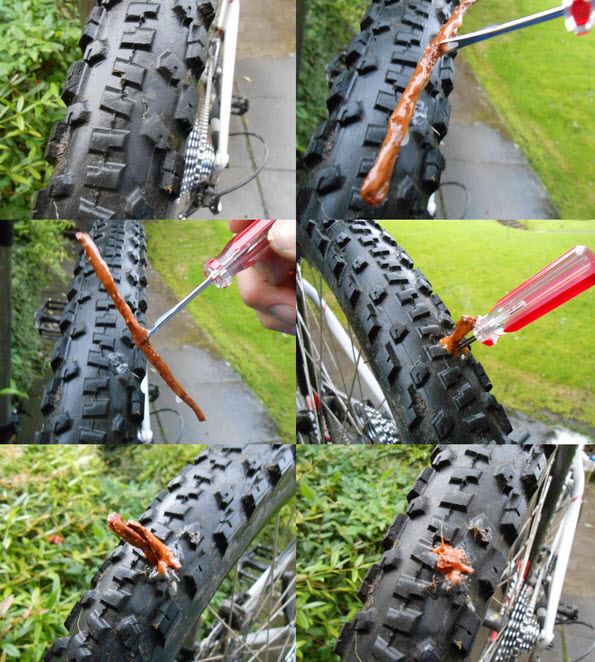 The system storage sleeves seemed to fit snugly with no noise or rattling but were not tested on the trail. Wolf Tooth does acknowledge that this system will not work with some ergonomic-style road bars with extra bends in the drops and has a running list of known bars that fall into this category.
The system storage sleeves seemed to fit snugly with no noise or rattling but were not tested on the trail. Wolf Tooth does acknowledge that this system will not work with some ergonomic-style road bars with extra bends in the drops and has a running list of known bars that fall into this category.
USD MSRP $49.95 (EnCase System Bar Kit One $119.95)
(Image credit: Danielle Tarloff // Future)
The Best “I don’t always puncture, but when I do I go big” Plug Kit
Plus strips included?: Yes, but only 2
Attached to or integrated into the bike?: No
+
Small and lightweight
+
Capable of repairing large punctures or tears.
+
Well-known brand name for sealant
-
Fussy to use
-
Failed to work on smaller holes.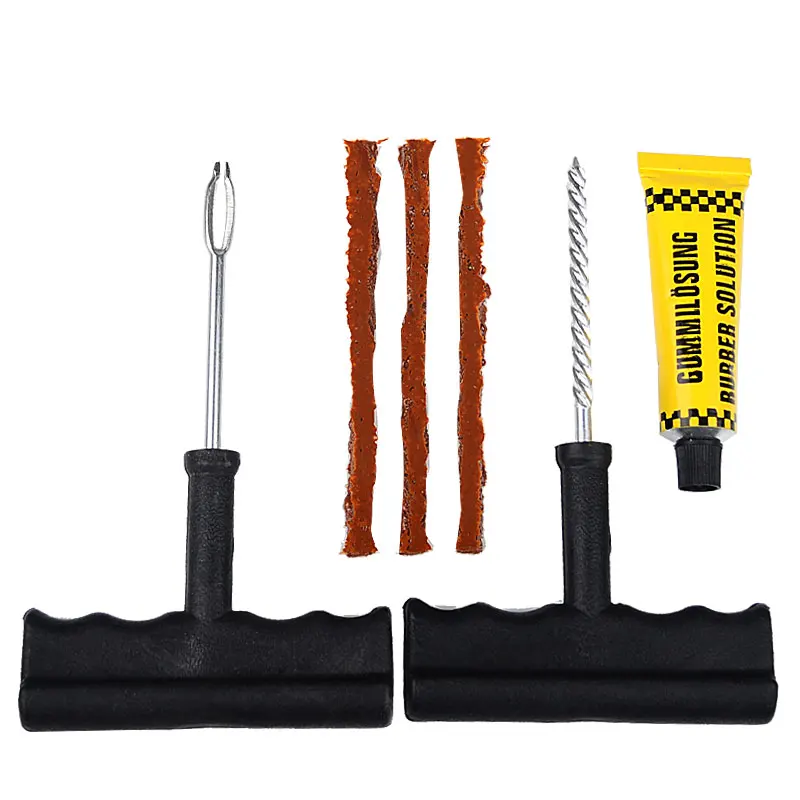
Today's Best Deals
The DART Tool is certainly a different concept than most of the other tools we tested and that came with its pros and cons. The light plastic body houses two large “Dual Action Repair for Tubeless” aka DART that are almost reminiscent of a badminton birdie, and the rods to insert them. While Stan’s describes these rods as “ultralight, corrosion-resistant and incredibly strong carbon” we had one break on the first attempt and don’t seem to be alone in this issue. Luckily the tool comes with two and the other side held up and sealed an ugly sidewall tear that any other plug or strip would have struggled with. To aid matters the DART is also said to create a chemical reaction with Stan’s sealant to enable a stronger and more durable fix. This benefit, however, only appeals if you’re already a Stan’s user.
With some breakage and the plastic head of the DART as a real struggle to insert, this tool might only be useful with large punctures. If you seem to tear sidewalls, or go big with punctures and need a way to get home, this might be the tool for you.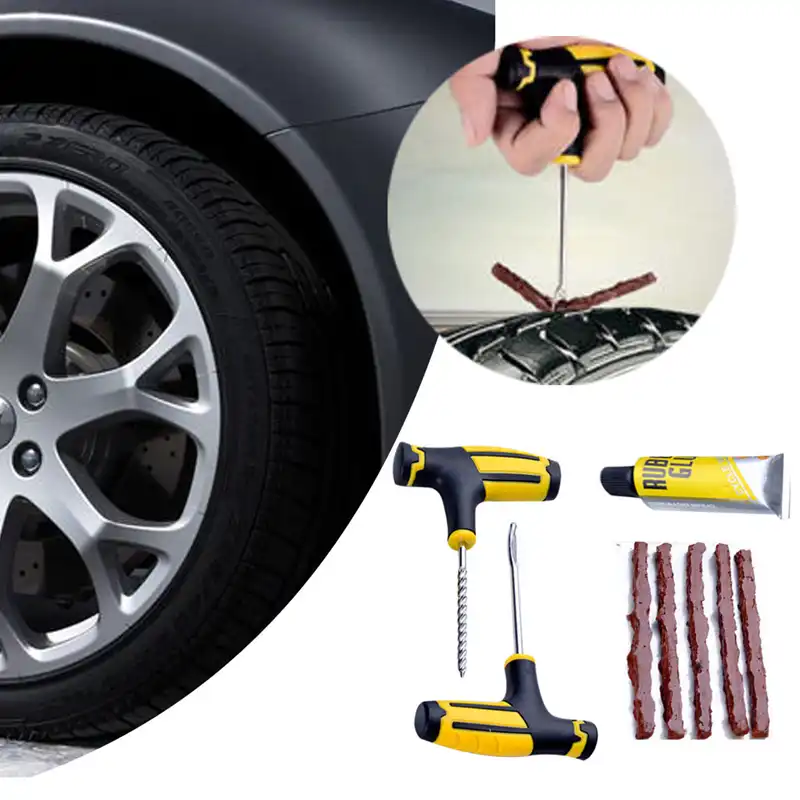
USD MSRP $25.00
(Image credit: Danielle Tarloff // Future)
The Best Inflator/Plug Kit
Plugs strips included?: yes, but only 3
Attached to or integrated into the bike?: No
+
Fast and easy to use
+
Useful CO2 inflation.
-
Expensive
-
Proprietary refill plugs.
Today's Best Deals
If you didn’t catch your puncture right away, chances are you’ll be airing up your tire as well as trying to plug a hole. The Dynaplug Air Kit takes all the ease of the system described in the Racer and adds a CO2 inflator. While a pump is typically handy to have on most adventures, CO2 can do the trick to help re-seat the bead of a tubeless tire if things have gotten quite flat.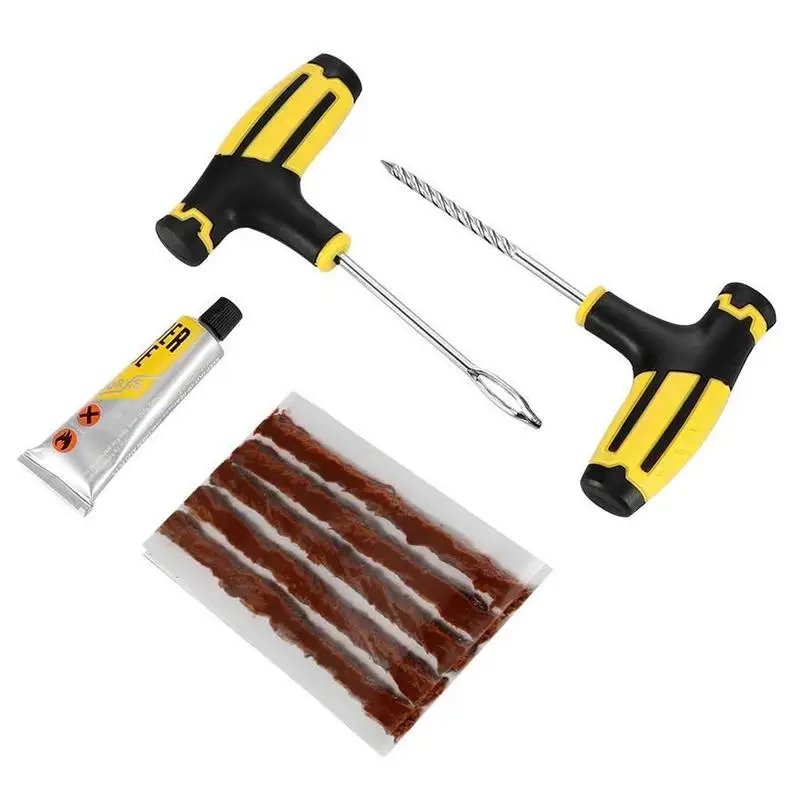 The versatile design allows you to inflate either through the puncture hole while repairing or separately through the tubeless valve. The hose that comes with the system is a clever attachment tool and is a great addition to an already slick system.
The versatile design allows you to inflate either through the puncture hole while repairing or separately through the tubeless valve. The hose that comes with the system is a clever attachment tool and is a great addition to an already slick system.
USD MSRP $74.99
(Image credit: Danielle Tarloff // Future)
The Super Wide Tire Plug Kit
Plug strips included?: Yes, plenty
Attached to or integrated into the bike?: Yes
+
Hidden in the bars, it's always with you.
+
Fun color options
-
Not fast to deploy
-
Somewhat MTB-oriented
-
Expensive
Today's Best Deals
This kit comes with the traditional fork encased in one bar end, a knife to trim plugs in the other, plus 3 packs of different size strips.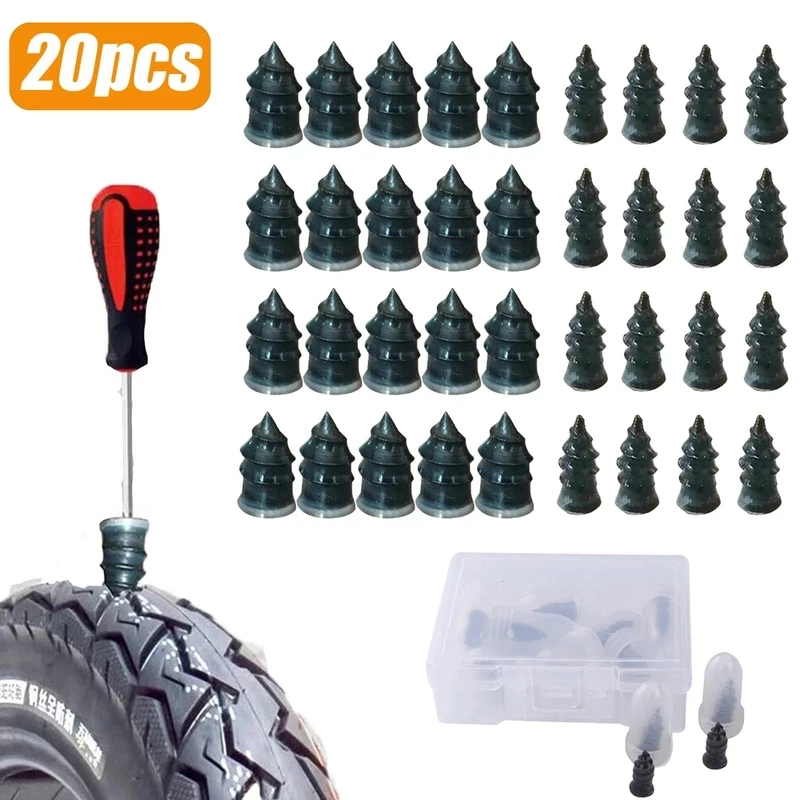 The strips are described as being small for road, medium for gravel tires, and large for mountain. The first attempt with the medium strip faired poorly with the tacky strip sticking to the tines of the fork and itself, failing to stay in the tire. A second attempt using the smaller strip went smoothly and held well despite a tricky placement right next to a knob. The knife to trim down the strip worked well and did not create any resistance or pull any of the strip back out as we were concerned it might. With this in mind, this kit may be best for a more aggressive gravel adventure bike or to share with a mountain bike.
The strips are described as being small for road, medium for gravel tires, and large for mountain. The first attempt with the medium strip faired poorly with the tacky strip sticking to the tines of the fork and itself, failing to stay in the tire. A second attempt using the smaller strip went smoothly and held well despite a tricky placement right next to a knob. The knife to trim down the strip worked well and did not create any resistance or pull any of the strip back out as we were concerned it might. With this in mind, this kit may be best for a more aggressive gravel adventure bike or to share with a mountain bike.
Having a color pop or color-coordinated bar end is also an appeal as these come in 12 color options. They are the most involved to fit into drop bars and also the slowest to remove. Utilizing the 4mm hex to get a comforting snug install also means you need the 4mm to get the tools out of the bar ends. It’s not a complicated ordeal, but potentially an issue of lost time and lost tire pressure and sealant.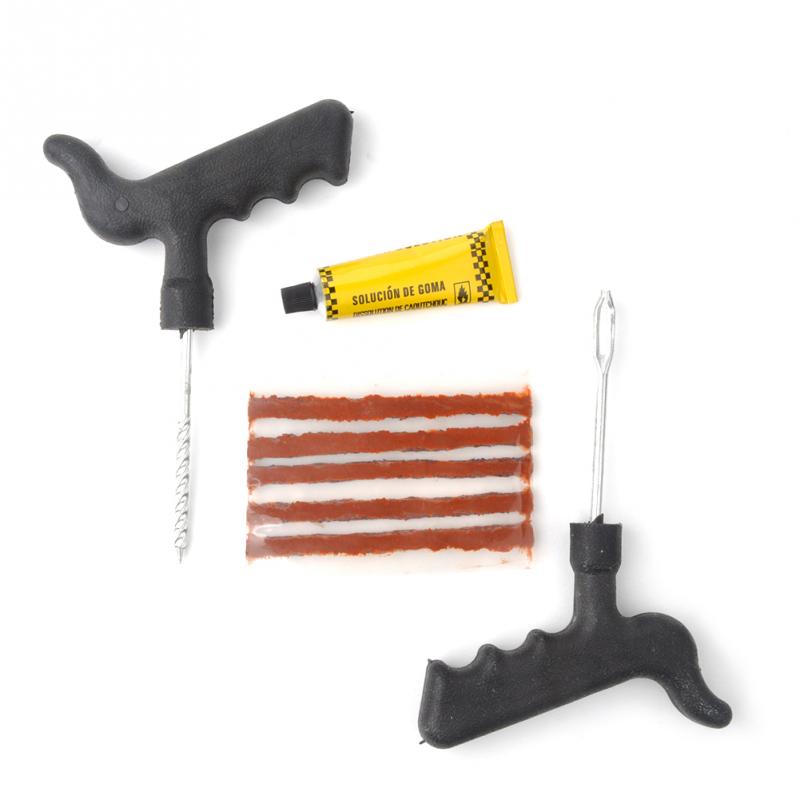
USD MSRP $49.99
(Image credit: Danielle Tarloff // Future)
The Best Bikepacking Plug Kit
Plug strips included?: Yes
Attached to or integrated into the bike?: No
+
Highly functional tool
+
Full-featured multi-tool system.
-
Spendy
-
Overkill if you already have a multi-tool
Today's Best Deals
Much like the other plug kit from Wolf Tooth, this system is stacked, quite literally as the full 8-Bit kit is comprised of several interlocking magnetic multi-tools. The Chain Breaker and Plug tool can be purchased separately, but are still a bit of an investment. While this kit is likely a few things too many for your usual day ride, it includes some of the items that you’d want to take bikepacking or touring, like master link pliers and a knife.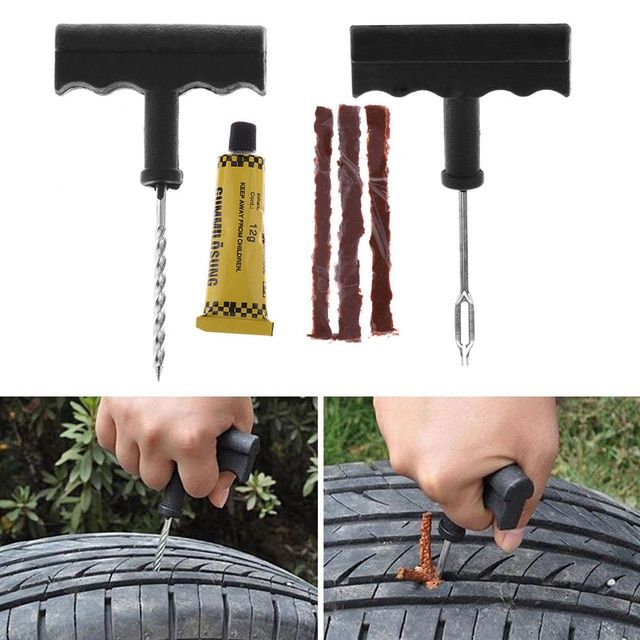
The tubeless portion is the usual fork with reasonable-sized strips. The way the tool is stored doesn’t allow for a pre-loaded strip as it stashes inside the tool body and doubles as the 3mm hex for the chain breaker. It is still satisfying to use with a large grip area and good leverage. As a fairly hefty tool it’s good for broader uses, but not what we’d suggest for fast deployment or race situations.
MSRP $69.96 USD (8-Bit Kit One or Two $139.95)
(Image credit: Anne-Marije Rook // Future)
Best Hidden Tire Plug
Plug strips included?: Yes
Attached to or integrated into the bike?: Yes
+
Several hiding place options
+
Durable construction
+
Easy to use
-
Not quickly accessible
Today's Best Deals
A tool that's hidden but always there. Granite's Stash Tire Plug seamlessly disappears in your handlebars or hollow axle crank, out of the way but there when you need it.
Granite's Stash Tire Plug seamlessly disappears in your handlebars or hollow axle crank, out of the way but there when you need it.
The quality aluminium all-in-one kit comes with a reamer and fork, medium-sized strips and two different end caps so you can choose to fit the stash tool in your handlebars, steerer tube or hollow crank for a small weight addition of 35 grams.
The tool looks super clean, and the reamer and fork itself will do the job at hand. But the insertion and removal of the tool does require an additional 4mm hex. It's also a tad time consuming, which results in quite a bit of air and sealant loss. Stashing the tire strips inside the tool is a bit of a squeeze but Granite doesn't provide a dedicated place to store them, meaning you either stuff them in with tool or carry them in a pack separately.
Lezyne Rap II-20 Tubeless multitool
What happened? Awkward to try and plug can’t preload - Could not get stip to stay in tire liked the idea of abrasive/reamer along tool, but might be best on larger tires only.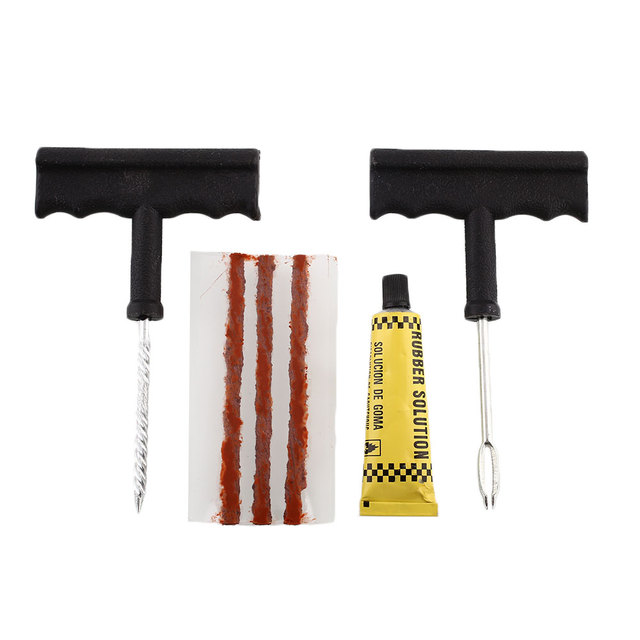
Price: MSRP $39.99 USD
Lezyne Tubeless Blaster
What happened? Could not get strip to stay in tire
Price: MSRP $49.99 USD
Genuine Innovations Tackle Kit
What happened? Goopiest feeling of the plugs and therefore hardest to thread into the tines. Includes two valve cores as well.
First attempt stuck to fork tines as I attempted to remove. Tried again and stuck to itself, turning into a goopy bacon ball. Second attempt was successful and seemed to hold.
Price: MSRP $28.99 USD
SWORD Plug Kit
What happened? Gigantic stips that really did not want to go into tire. Easily installed into the ends of drop bars. No obvious storage for extra plugs. Pre-loaded is loose inside bar can dry out or stick to inside of bar. “Counter clockwise spiral twist ensures lock and release mechanism for a tight and secure fit in the bar end. (ensuring plug still stays dry and sticky)”
(ensuring plug still stays dry and sticky)”
Price: MSRP $24.95 USD
Round up of today's best deals
Reduced Price
Blackburn Plugger Tubeless Tire Repair
£17.99
£14.42
View
See all prices
Dynaplug Tubeless Repair
£25.99
View
See all prices
Wolf Tooth EnCase Chainbreak Tire Plug
£68.74
View
See all prices
Stan's DART Tool
£18
View
See all prices
DynaPlug Air Kit
£54. 86
86
View
See all prices
Muc-Off Stealth tubeless plug
£32
View
See all prices
powered by
Danielle studied Journalism at Northeastern University in Boston, MA where she began commuting around the city and exploring historic areas by bike. With over 15 years in the cycling industry, she's seen and ridden her share of technologies and trends, but believes that it's probably a good thing if it gets someone out riding. She has pinned a number on for a couple of cyclocross races, and a handful of endurance events, but her favorite rides include adventures in questionable terrain and a stop for snacks.
Considering a tubeless tire setup for a long international trip? Or just hoping to have flatless bikepacking outings in your own backyard? Here’s our complete field guide to tubeless with a full tubeless tire repair kit, how-to videos for repair and setup, plugger options, and tips from the road…
compose Team Work
time Jun 19, 2020
comment 79
Despite the fact that most of the mainstream mountain bike world has converted, many bikepackers and bike tourers remain cautiously hesitant to transition to a tubeless setup, especially for big long-distance trips. We get it. For folks who haven’t performed their own tubeless conversion, it can seem like a daunting task. To some, it remains a dark art… or at least, a complicated operation that requires special skills, a compressor, and general mechanical savvy to successfully complete.
We get it. For folks who haven’t performed their own tubeless conversion, it can seem like a daunting task. To some, it remains a dark art… or at least, a complicated operation that requires special skills, a compressor, and general mechanical savvy to successfully complete.
Tubeless Tire Setup
Tubeless Tire Repair
Tubeless Tire Repair Kit
Pluggers
Tips for Traveling Tubeless
But we’ve put this guide together in hopes of convincing you otherwise. In our opinion, tubes have long been dead. Just go for a long dirt road tour in South Africa. Or spend a few days out on the Arizona Trail. Or bomb down a rocky trail in backcountry Peru. Never having flats rules… period. Combined with the ability to run lower tire pressures for a more compliant ride—especially given the popularity of larger volume tires and wider rims these days—we think everyone should be running tubeless tires at this point. Not only are most rims and tires now optimized for tubeless, many new bikes are ready to convert, or are already tubeless out of the box. In addition, there’s a multitude of great tubeless repair tools and pluggers on the market, making repairs easy once you have the basics down.
Not only are most rims and tires now optimized for tubeless, many new bikes are ready to convert, or are already tubeless out of the box. In addition, there’s a multitude of great tubeless repair tools and pluggers on the market, making repairs easy once you have the basics down.
To help demystify the whole process, here’s our full field guide with videos, tips, tricks, and a full tubeless repair kit to get you started and keep you rolling. We encourage you to give it a try; experience is more valuable than anything. Further down the post, you’ll also find two full video guides that we put together. But first, some basics on tires and rims.
Although most modern rims are “tubeless ready” these days, there are still new bikes that get specced rims that are not. The most prevalent feature on a tubeless ready rim is that the rim bed features bead-locks, or small ridges in the flat section of the rim profile that help prevent burping (when the bead momentarily breaks and air is burped out).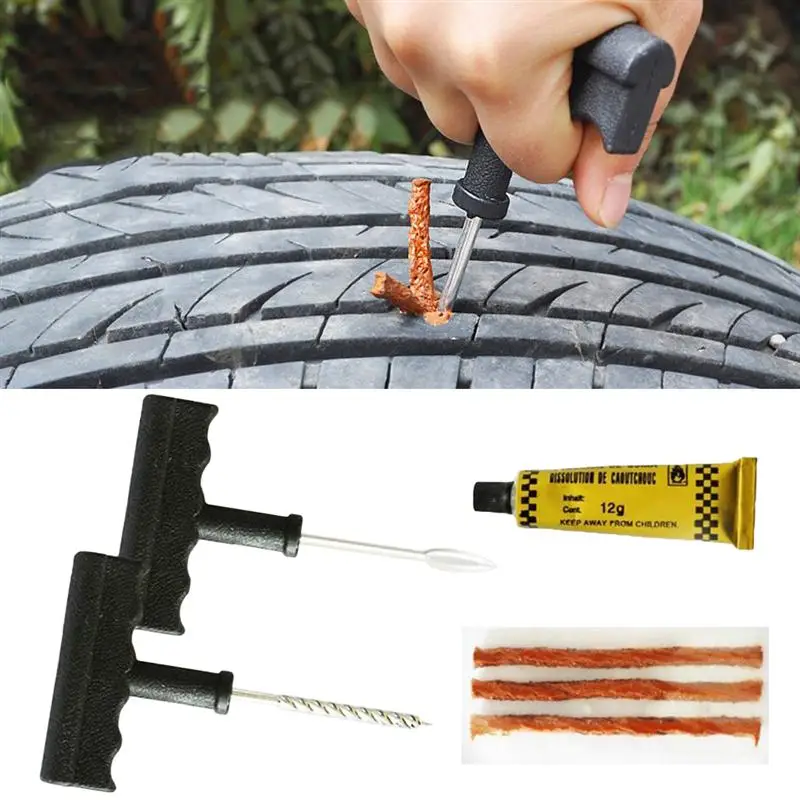 Meanwhile, a properly designed center channel makes a loosely mounted tire “grab” air and snap over the bead locks. The latter is the key to their ease of tubeless tire installation.
Meanwhile, a properly designed center channel makes a loosely mounted tire “grab” air and snap over the bead locks. The latter is the key to their ease of tubeless tire installation.
Although you can often use standard tires for a tubeless setup, a tubeless ready (TR) model will likely seal better due to its optimized bead design. You’ll appreciate this all the more when installation conditions aren’t optimal. TR tires also tend to have reinforced sidewalls; given that a tubeless tire is run at lower pressures and can be more susceptible to sidewall cuts, this is especially welcome. If TR models aren’t available to you, we prefer tires with lower TPI counts for long-distance travel.
Setting up your wheels and tires tubeless isn’t as difficult as you might think. Watch our video setup guide below, along with some tubeless setup tips. Also, scroll to the bottom of the page to find our step-by-step guide to setting up tires tubeless before and after flying with your bike.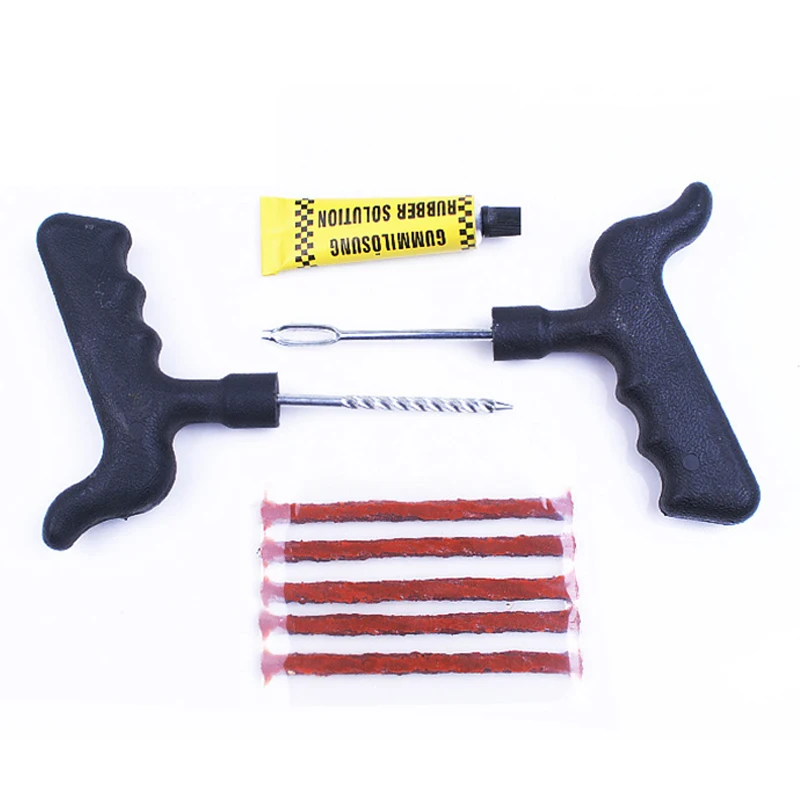
Properly taping the rim is crucial to a successful tubeless setup. Start by cleaning the inside of the rim. Use rubbing alcohol or a degreaser to get any residue or factory finish off the rim. This ensures that the tape will stick. Use the widest tape possible to fit in the face of the rim. As for brands, WTB TCS tape works well and comes in several widths. With the disc rotor facing you, tape the rim in a clockwise rotation, which allows the force of the tire sealant liquid to not agitate the tape seam (the clockwise rotation of the wheel will generally allow the liquid to flow over the seal and not against it). Start the tape on the face opposite the valve stem hole and allow a 1” to 2″ overlap. After taping, carefully cut a smooth hole for the valve stem using a sharp blade.
For a tubeless tape job that lasts, we highly recommend mounting the tire with a tube inside before setting it up with tubeless sealant. Doing so ensures that the tape fully seals to the rim and keeps sealant from penetrating under the tape and causing it to peel up over time. Inflate the tube to the typical maximum pressure recommended for your tires and let it sit overnight. The next day, unseat one side of the tire and remove the tube. This helps the tire create the “memory” of its shape, which aids in the initial setup. Here’s a nice and clear how-to video from WTB for reference.
Doing so ensures that the tape fully seals to the rim and keeps sealant from penetrating under the tape and causing it to peel up over time. Inflate the tube to the typical maximum pressure recommended for your tires and let it sit overnight. The next day, unseat one side of the tire and remove the tube. This helps the tire create the “memory” of its shape, which aids in the initial setup. Here’s a nice and clear how-to video from WTB for reference.
Here’s our full video guide to tubeless tire repair. Watch it, then scroll down to find important tips, tools, and other information.
This is a useful skill to acquire, given that some tubeless tires are more prone to sidewall failures than regular ones. This is especially important when planning a desert adventure, where jumbles of razor-sharp rocks often abound.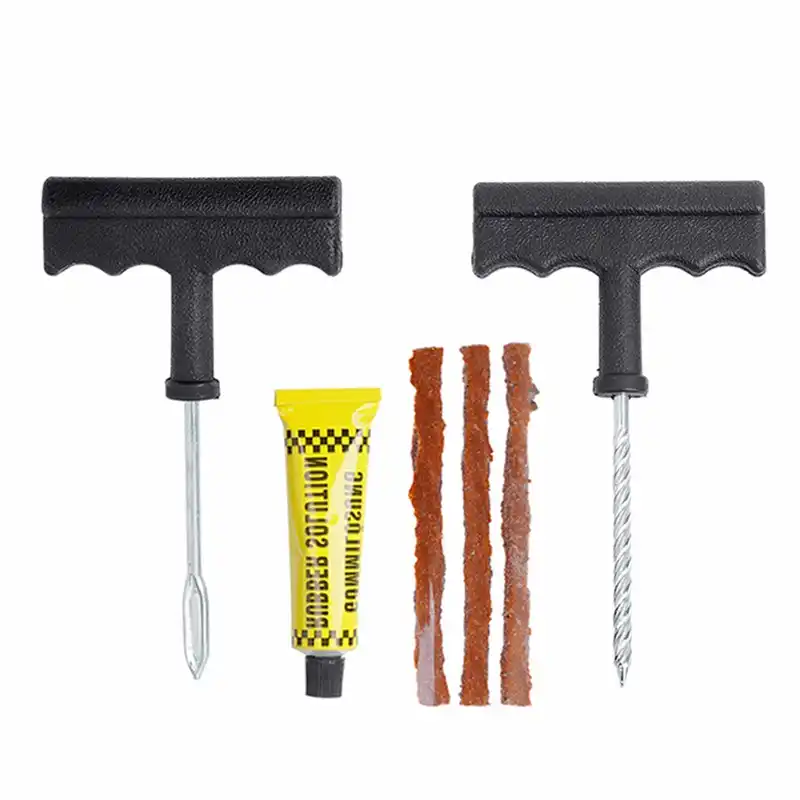 Tire plugs will repair most cuts; use them with the tool provided to blot a tire wound. To fix larger cuts without unseating the tire, carry a heavy, curved needle and a length of dental floss to sew the cut up first. A dab of superglue over the dental floss is recommended. For longer, 2” to 3” gashes, add a section of sidewall cut out from an old tire, using Shoe Goo (REI sells small containers) to glue in the boot after sewing the cut. Let the glue dry overnight with an inflated tube in place to hold pressure on it–it’s rare to have a cut so bad that you can’t wait till night to do this. If your repair won’t hold, make sure you have a couple of inner tubes on hand. Just be sure to remove all the thorns from the casing before you fit it!
Tire plugs will repair most cuts; use them with the tool provided to blot a tire wound. To fix larger cuts without unseating the tire, carry a heavy, curved needle and a length of dental floss to sew the cut up first. A dab of superglue over the dental floss is recommended. For longer, 2” to 3” gashes, add a section of sidewall cut out from an old tire, using Shoe Goo (REI sells small containers) to glue in the boot after sewing the cut. Let the glue dry overnight with an inflated tube in place to hold pressure on it–it’s rare to have a cut so bad that you can’t wait till night to do this. If your repair won’t hold, make sure you have a couple of inner tubes on hand. Just be sure to remove all the thorns from the casing before you fit it!
Although one tube is often enough, we’d always recommend carrying at least two spare inner tubes when heading overseas, especially if you’re running an unconventional tire size. Generally speaking, your spare tubes can be ultralight models, as it’s unlikely they’ll be needed. Just make sure you baby them! It’s easy to leave them languishing in the bottom of a frame bag, where they’re prone to abrasion. We wrap one in tape and attach it to the bike, and store another in a thin sock for protection. Some use a ziploc bag with baby powder, as legend has it a little talc allows the tube to move inside the tire, and may help eliminate pinch flats from twisted during installation. If and when they’re needed, be sure to check your tire thoroughly first. Most likely, it will be riddled with thorns or other debris. In a pinch, you can always run conventional 26” tubes on a 29er, or even a fat bike.
Just make sure you baby them! It’s easy to leave them languishing in the bottom of a frame bag, where they’re prone to abrasion. We wrap one in tape and attach it to the bike, and store another in a thin sock for protection. Some use a ziploc bag with baby powder, as legend has it a little talc allows the tube to move inside the tire, and may help eliminate pinch flats from twisted during installation. If and when they’re needed, be sure to check your tire thoroughly first. Most likely, it will be riddled with thorns or other debris. In a pinch, you can always run conventional 26” tubes on a 29er, or even a fat bike.
We’ve posted a full-blown bikepacking repair kit in the past, but here’s the tire repair kit of the future. Start by thinking less about tubes and more about repairing your tires and keeping them sealed.
Although this may vary depending on tire volume, we recommend carrying 2oz of sealant for small day rides or overnighters, at least 4oz of sealant for trips up to a few weeks, or for extra long trips, make it 8oz.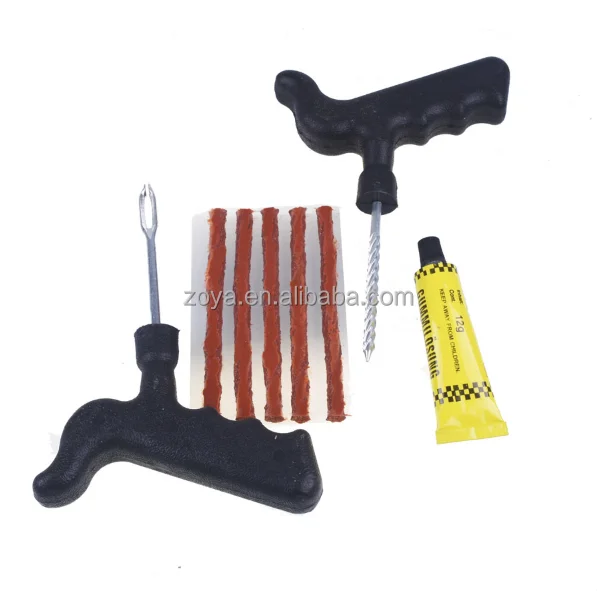 Orange Seal comes in handy 4oz injector bottles. Orange Seal Endurance is a favorite for several of us here.
Orange Seal comes in handy 4oz injector bottles. Orange Seal Endurance is a favorite for several of us here.
Always carry at least one tube. To be ultra safe or for longer trips, carry two. And as mentioned above, be sure to take extra care of it by storing it in a Ziploc bag.
Roll a dozen or so winds around your pump. Gorilla tape can be used to help with a tire tear or to re-tape a rim, in addition to a ton of other miscellaneous uses around camp.
Carrying a patch kit is a must. In the event of having to use a tube, you’ll likely need to patch it down the road, particularly if you are traveling through desert landscapes where thorns or goatherds are prevalent. Pro tip: make sure the cement isn’t dried out and the sandpaper is in good shape. Also, alongside a tube, we’ve used patches to seal small sidewall cuts, much like a tire boot.
Super glue or shoe glue can help aid in the repair of a tire tear in the tread area or sidewall. You can even put glue around a plug for additional support, or on the adhesive side of tape and create an ultra strong bond.
You can even put glue around a plug for additional support, or on the adhesive side of tape and create an ultra strong bond.
It’s easy to damage a valve, have one clog up, or even loose the core while working on a trailside repair. So, carry an extra. They’re small enough.
These work well for punctures that are too big for the sealant but not so big you need a boot. It should provide a permanent repair for most normal punctures. Find a full list of plugger options below. Also note that if you are out of plugs, you can wedge in bits of cloth, rope, or other sealant absorbing materials to stop a leak. This can be especially handy if the hole is larger.
A heavy duty curved upholstery needle and nylon thread are useful for fixing larger cuts without unseating the tire. You can also use this to repair a bikepacking bag, if need be. This looks like a suitable option.
For 2-3″ gashes, this can be glued into place.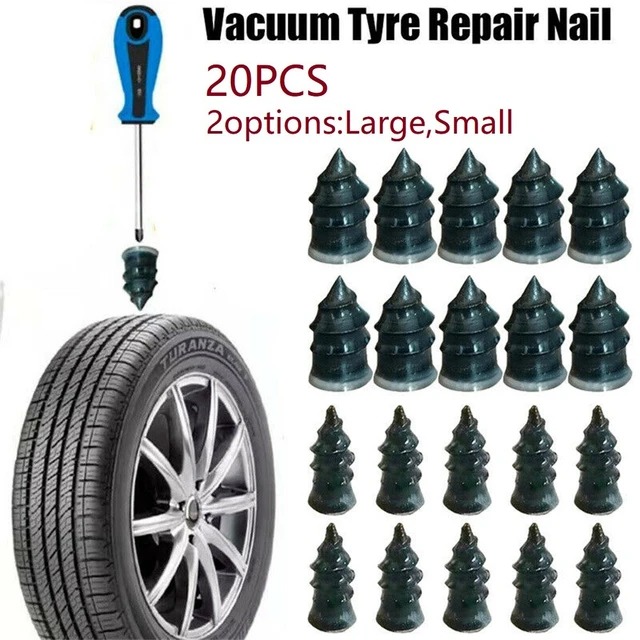
Although a dedicated valve core removal tool is best, the pliers on a Leatherman work. However, you might risk messing up the threads if you use a pump with a threaded head. The spoke wrench on your multitool may work to remove valve cores, too. If you lose your valve core tool… whittle one from wood! (see photo)
Last but not least, a good pump is a must. One of our favorites is the 100cc OneUp EDC pump ($59). Also, the Lezyne Micro Floor Drive HV ($65 with gauge) has proven useful and durable. The latter is a bit more powerful, but the screw-on head can be a little annoying, causing the unexpected removal of the core when unscrewing it from the valve. And if you’d rather not have a larger pump, you can also make your own tubeless tire inflator.
With a proper tubeless setup, and generally tough tires, it’s not often that you have to resort to tire plugs. However, they’re an indispensable part of a proper bikepacking repair kit. And since tubeless tires have become ubiquitous with modern mountain bikes, there’s a wealth of tire pluggers on the market. Most are based around the classic tiny screwdriver-esque mini-plugger that’s used to insert small sticky plugs, aka bacon strips. These integrate a similar tonged metal fork into another tool, case, or handle. For most of these types of pluggers you can buy the plugs separately. Others, such as the Dynaplug, or Stan’s Dart, use proprietary plugs. Find a list of some of the more popular options below. Note that there are a few affiliate links here. We prefer that you buy from and support your local bike shop, but if you must buy online, we get a very small kickback if you purchase via these links.
However, they’re an indispensable part of a proper bikepacking repair kit. And since tubeless tires have become ubiquitous with modern mountain bikes, there’s a wealth of tire pluggers on the market. Most are based around the classic tiny screwdriver-esque mini-plugger that’s used to insert small sticky plugs, aka bacon strips. These integrate a similar tonged metal fork into another tool, case, or handle. For most of these types of pluggers you can buy the plugs separately. Others, such as the Dynaplug, or Stan’s Dart, use proprietary plugs. Find a list of some of the more popular options below. Note that there are a few affiliate links here. We prefer that you buy from and support your local bike shop, but if you must buy online, we get a very small kickback if you purchase via these links.
The Genuine Innovations Tubeless Tire Repair Kit is the most basic and inexpensive plugger on the market. For just over $6, you get the miniature screwdriver-like plugger tool and “Side of Bacon” (five rope repair plugs).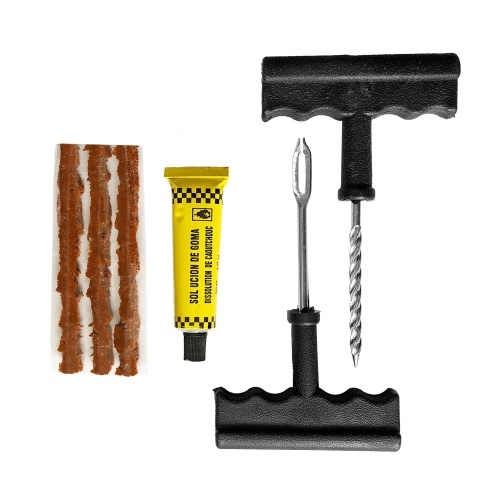 It works, it’s cheap, and it’s fairly easy to use. $6.38 on Amazon.
It works, it’s cheap, and it’s fairly easy to use. $6.38 on Amazon.
The Dynaplug Micro Pro tubeless repair kit is designed to be a quick and easy puncture tool. The crux of the patented system is a two-piece aluminum body with a hollow stainless steel insertion tube that’s threaded into the handle. The tube is preloaded with a repair plug where it sits in place, ready for action. The repair plugs are each made of a proprietary rubber-impregnated cord mounted to a pointed, non-abrasive brass tip. The other side of the “pill” features a honeycomb of tools, including an awl for clearing the hole and a small knife for cutting off excess plug material. We’ve used one quite a bit and they are certainly the most user-friendly plugger we’ve ever used. Read our review here or pick one up at Dynaplug’s Amazon store for $59. Dynaplug also makes the Racer, shown above, with the larger blunt-end plug for bigger tears on one side and the smaller plug on the other. $49 on Amazon.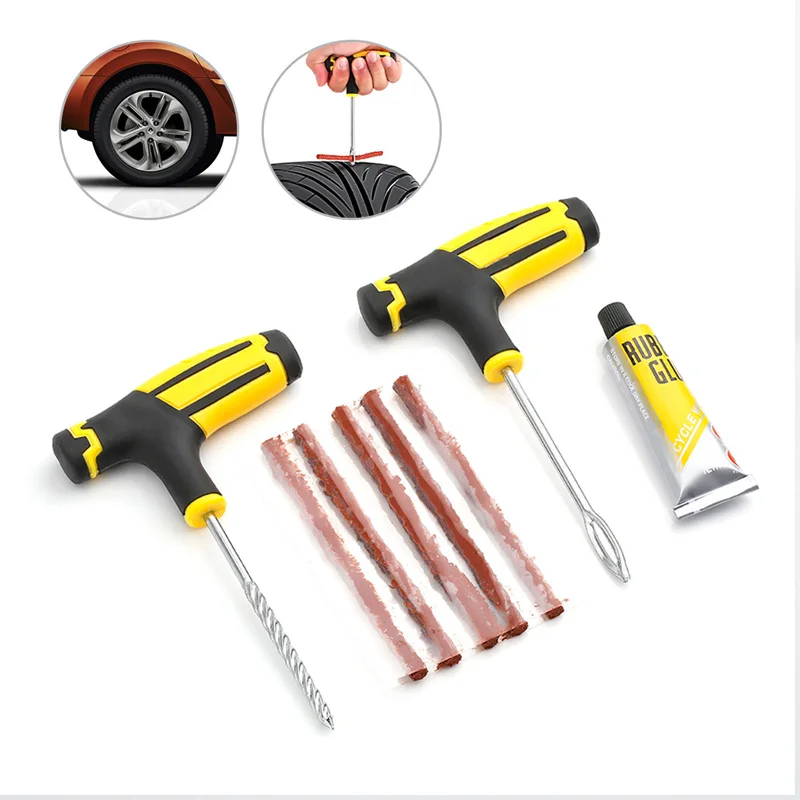
The Wolf Tooth Encase Bar Kit One is a handy toolkit that stashes in your bar ends. One side has a multi-tool and the other has a chain breaker and a threaded cap that reveals a tubeless tire plugger, as well as a hollow chamber containing a five-pack of small tubeless plugs. It works similarly to a standard miniature plugger tool and uses the same plugs. Read our review here. You can find the Bar Kit One at some bike shops or buy one online for $120.
Similar to the Wolf Tooth Encase, OneUp’s EDC Pump and Tool has a small cylinder with a threaded cap. On the inside of the cap is a tubeless repair tool and the cylinder has enough room to store a dozen plugs. The EDC Pump is one of the best we’ve used and having the tool and tubeless repair kit all inside makes it a no-brainer for day rides or bike trips. Read our review here. The full EDC system isn’t cheap. You have to buy three different components: the pump for $59, the Tool for $59, and the Plug and Pliers Kit for $39.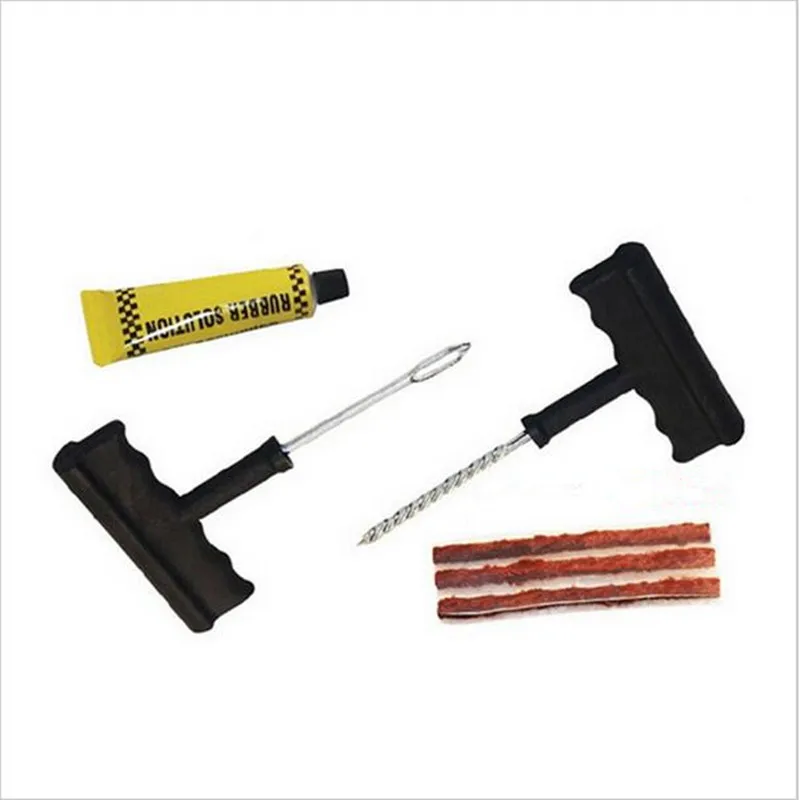 But, we’ve been using one regularly for several years and have zero complaints.
But, we’ve been using one regularly for several years and have zero complaints.
The Lezyne tubeless repair kit features an oversized repair fork and oversized plugs. These are double the size of typical tubeless plugs, so certainly better for larger holes and tears. Lezyne plugger retails for $19.99.
As part of Granite Designs’ Stash Tool line, the Stash Tire Plug uses an expandable rubber plug and aluminum cap to tuck away in the end of your handlebar. An aluminum sleeve houses a fork-style applicator, reamer, and four tire plugs, providing a sleek and easily accessible home for all of your tire plugging needs. Read our review here.
While other pluggers, such as the Dynaplug or typical “bacon strips,” are designed to wedge sticky rubber strips into a puncture, the DART’s plugs feature a hackle of specially designed material that’s engineered to create a chemical reaction with Stan’s sealant to quickly form a permanent airtight bond.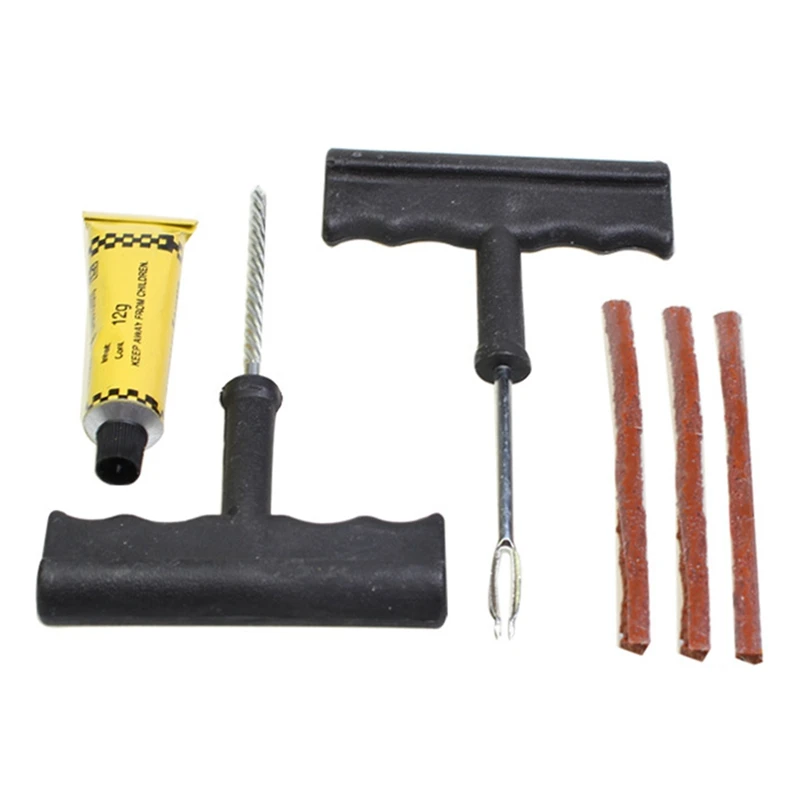 We’ve yet to try the Dart, but will update this if we do. The Dart retails for $25.
We’ve yet to try the Dart, but will update this if we do. The Dart retails for $25.
The Sahmurai Sword (named after the creator Stefan ‘Sahmurai’ Sahm) uses a unique twist-to-lock design, replacing your bar end plugs with two impact-resistant rubber tools: one reamer and one fork-style applicator. The plug itself is held by the applicator within the bar, which means extra plugs must be carried elsewhere. Learn more over at Sahmurai.com.
One roadblock to tubeless for a lot of people is traveling with your bike—particularly travel that involves flying. For the most part, you can set your bike up tubeless beforehand, and simply add a little extra sealant and inflate your tires upon landing. Away from the comforts of your workshop or local bike shop, this might seem challenging, but with the right rims and tires, and a little preparation, it’s actually pretty easy. Here are a few tips we’ve learned over the years.
It’s never a good idea to start a big bikepacking trip on fresh tires, regardless. Tires can sometimes have defects, so giving them a proper test beforehand is always a good idea. This also ensures a proper tubeless seal. Four or five good rides can help get the sealant in all the right places.
Tires can sometimes have defects, so giving them a proper test beforehand is always a good idea. This also ensures a proper tubeless seal. Four or five good rides can help get the sealant in all the right places.
For trips that require travel, one method we’ve used in the past is to be conservative with the amount of sealant you use initially. This isn’t necessary, but it saves a mess if your tire seals break in transit. If you choose to go this route, bring extra sealant to add to it once you arrive at your destination. As an example, for two 29+ bikes, we found that one 16oz bottle of Orange Seal, one 4oz injector kit, and a spare empty 4oz bottle did the trick for adding sealant upon arrival and ensuring enough backup sealant for a two-month trip.
If you’re flying with your bike, let most of the air out of the tires, as required by most airlines. Be sure not to completely deflate the tire though, to protect your rims, and minimise the chance of the bead unseating.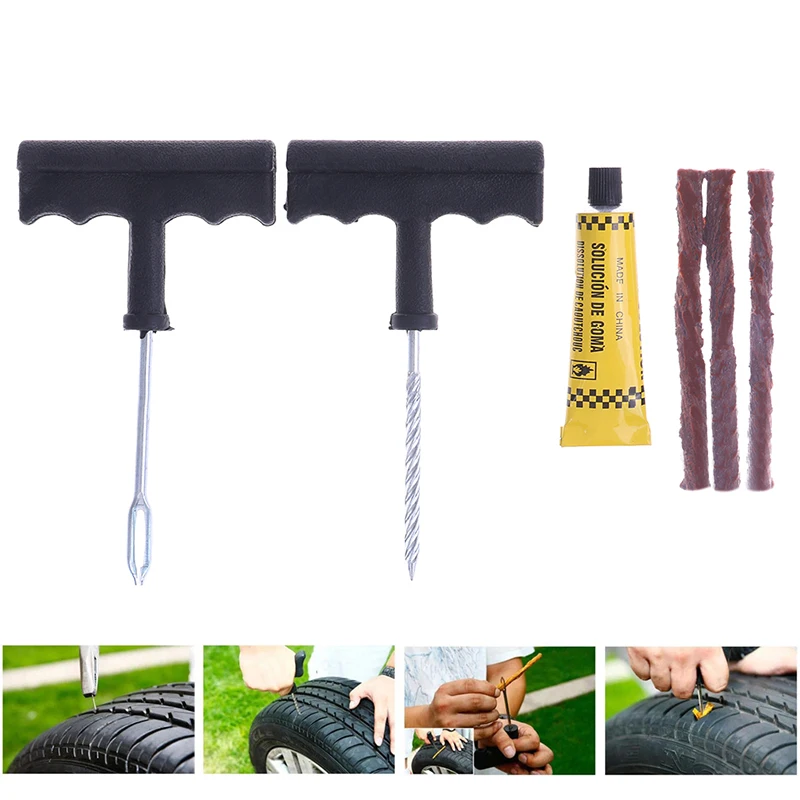 When you box your bike, rotate the wheels to make sure the wheels are rotated so that the valves are at the top—this will prevent sealant from settling in the valve and clogging the core.
When you box your bike, rotate the wheels to make sure the wheels are rotated so that the valves are at the top—this will prevent sealant from settling in the valve and clogging the core.
If your bead seals get broken in transit, you’ll have to repeat the set up procedure from the comfort of your hostel or hotel. Inflate with a mini pump (as mentioned above, we highly recommend a high volume pump like the 100cc OneUp EDC, or Lezyne’s Micro-Floor Drive HV). If you’re having a hard time getting the bead to push into place while pumping vigorously, try working the bead against the bead-lock lip. Sometimes it helps to have a friend hold the wheel off the ground, while an extra pair of hands can also help move the bead toward the rim while you’re pumping. If such hands aren’t available, we’ve also found that two Surly Junk Straps to cinch the tire into place can really help. Failing this, a trip down a local mechanic with a compressor should do the trick.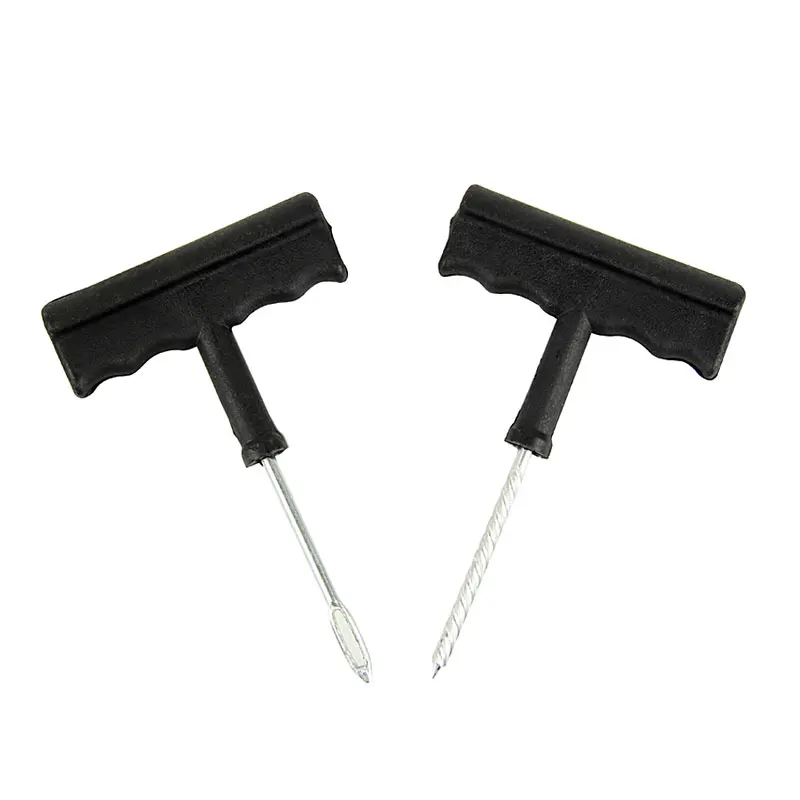 When the tire is inflated, check that it’s seated evenly. Extra pressure will generally encourage it to snap into place. If not, deflate, moisten the bead with soapy water, and try again.
When the tire is inflated, check that it’s seated evenly. Extra pressure will generally encourage it to snap into place. If not, deflate, moisten the bead with soapy water, and try again.
Have any tubeless repair tips or tricks to share? Or stories from the road? Leave us a comment below…
Please keep the conversation civil, constructive, and inclusive, or your comment will be removed.
Today, car dealers offer various repair kits for both tubeless and tubed tires. In our review, we will consider the best car tire repair kits.
These kits include a standard set of items:
 A tool equipped with a T-handle, with which it is convenient to expand the puncture site for inserting a rubber band. On its tip there is an eyelet, like a large needle, with which a rubber insert is inserted into the puncture site.
A tool equipped with a T-handle, with which it is convenient to expand the puncture site for inserting a rubber band. On its tip there is an eyelet, like a large needle, with which a rubber insert is inserted into the puncture site. From different manufacturers, you can also find files for cleaning the rubber surface, a pressure gauge for checking the pressure in it, and spools in the kit.
Russian company's kit for repairing damages in car tires as a result of screws, nails, etc.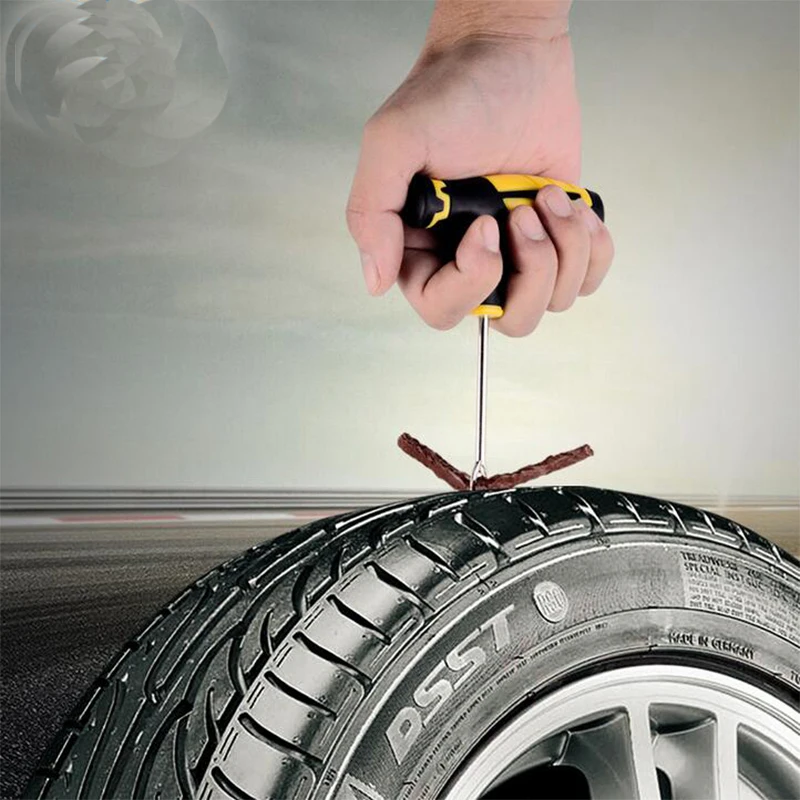 getting into them. Designed for repairing tubeless tires. The kit helps to eliminate a puncture in rubber with a diameter of up to 6 mm.
getting into them. Designed for repairing tubeless tires. The kit helps to eliminate a puncture in rubber with a diameter of up to 6 mm.
Pluses of the set:
Cons of dialing:
Made in China. It has a very affordable price and a nice packaging design. With it, you can quickly and effectively close a hole in the tire. Effective adhesive holds the tourniquet firmly into the hole.
Using a similar product, you can repair a hole in the rubber without removing the wheel from the car. Working time - 5-7 minutes.
Pluses of the set:
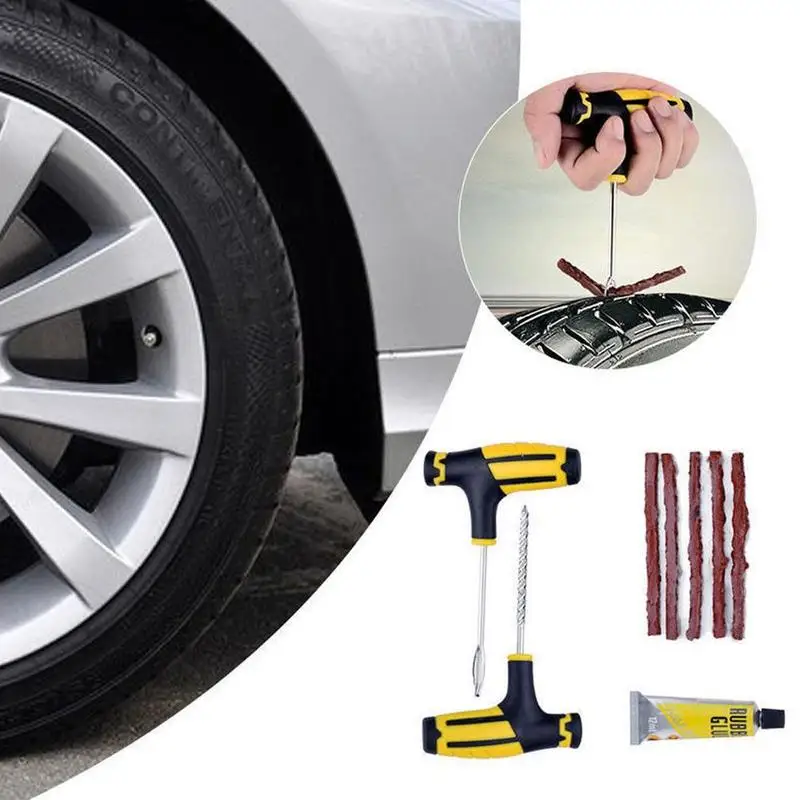
Cons of the set:
This German brand product is made in China. The set includes standard items for such a product: a rasp and an awl, glue and 5 tourniquets. The small size of the repair kit: 320x180x30 mm and weight 220 g allows the motorist to place the kit in any corner of the car.
Kit plus:
Cons of the set:

Similar kits can be used to eliminate punctures not only in car tires, but also in motorcycles.
Another “made in China” kit that pleases car enthusiasts with its affordable price and benefits. Its use will allow you to do without the costly call of a tow truck or the cost of tire fitting services.
Transparent plastic package contains everything you need to repair a tire: rubber bands-inserts (5 pcs.), glue and tools.
Pros:
Cons of dialing:
In practice, a wheel repaired in this way will not bother the driver for a long time.
Products of the American company RunWay, whose production facilities are located in Russia and China. Raw rubber, from which the harnesses are made, effectively fills the puncture space by self-vulcanization.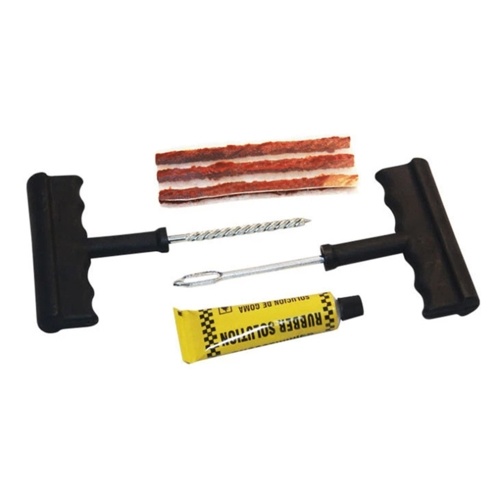 In addition to it, the kit includes a rasp, an awl and glue.
In addition to it, the kit includes a rasp, an awl and glue.
Kit pluses:
Cons of the set:
Motorists unanimously claim that such a set is necessary in the car.
Various repair kits are used to fix damage to tube tires. Some include raw rubber patches, sandpaper and glue, while others include a set of mushrooms: rubber patches with legs.
This Russian brand tire repair kit includes two sets of raw rubber patches (6x round) and 2x rectangular shape, as well as glue and sandpaper. Using sandpaper, the puncture area is cleaned, then a patch corresponding to the size of the hole is selected and glued to the damaged area.
Pluses of the set:
Cons of dialing:
In this way, you can patch a hole in a car, bicycle or motor rubber.
An effective tool for the repair of tube and tubeless tires is the fungus kit of the American company X-Tra Seal. With its help, it is possible to carry out high-quality repair of tires on the running and side parts.
The 55 mm diameter of the cap allows you to repair damage of a fairly serious size. The leg length of 55 mm makes repairs convenient and fast.
Advantages of the set:

Cons of dialing:
It must be remembered that such patches can be installed on the tread and sides of all passenger cars. The exception is high-speed tires of the H index and with a higher value: in this case, the fungi are placed only on the tread.
The German company Tip-Top offers motorists in the event of a tire puncture to use the proven fungus with 6 mm caps. Such products can qualitatively eliminate tire damage with a diameter of up to 3 mm.
The rubber cap of the fungus covers the damaged area from the inside of the tire, and the foot covers the puncture area.
Advantages of the set:
Cons of dialing:
The inner surface of the fungus and the outer surface of the stalk self-vulcanize, providing an airtight bond with the rubber compound of the tire.
This is the product of another Russian-Chinese company that produces materials for tire fitting. The dimensions of damage to the chamber for repair by this method are limited: no more than 35 mm in the longitudinal direction and 25 mm in the transverse direction.
After treatment of the puncture zone, its surface is degreased and adhesive composition is applied. The patch treated with the same glue is pressed with force to the puncture site and passed over it with a roller. Before sticking it is necessary to remove the protective film from the patch.
The patch treated with the same glue is pressed with force to the puncture site and passed over it with a roller. Before sticking it is necessary to remove the protective film from the patch.
Advantages of the kit:
Cons of dialing:
Another tool that helps a car enthusiast to get at least to the nearest service is a patch patch of the German brand Tip-Top 43 by 43 mm in size. They can eliminate micropunctures, minor damage.
Set plus:
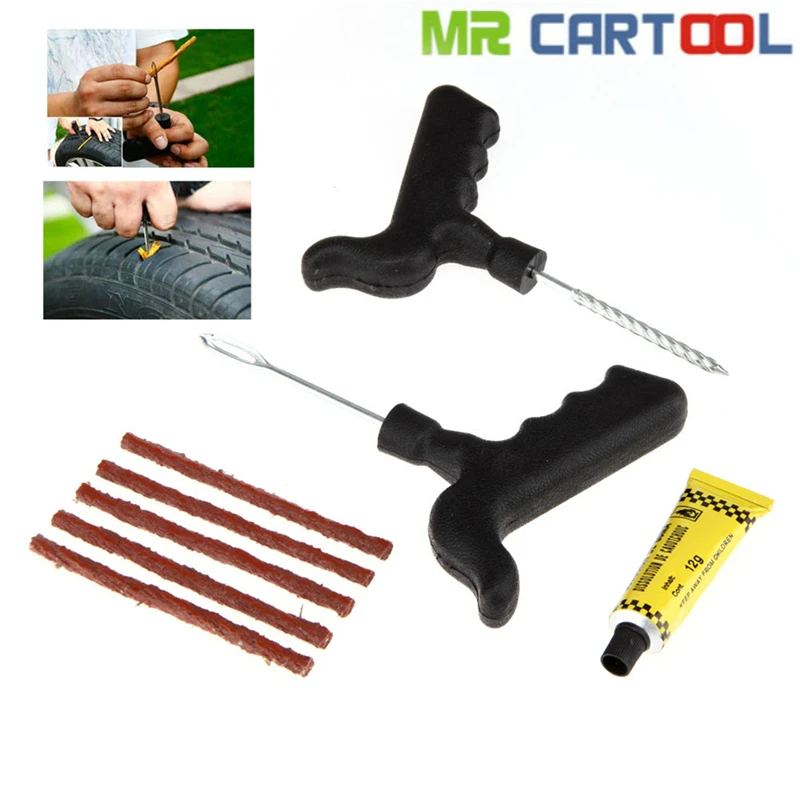
Cons of dialing:
One of the problems that can take the driver by surprise is a flat tire on the road. Such unpleasant moments can be created by an ordinary small nail or self-tapping screw, which can pierce tires. What to do in this case? Do not immediately look for a service station or buy new tires. You can easily repair your wheel yourself using a tubeless tire repair kit.
It is not uncommon for a car wheel to be pierced by a nail you run into on the road. What to do? First of all, it is necessary to get a piercing object from the puncture site. But to do this is not so easy. If you pull out a nail, for example, with ordinary wire cutters, then a hole will remain in its place, through which air will escape from the chamber, and you will not be able to use your vehicle.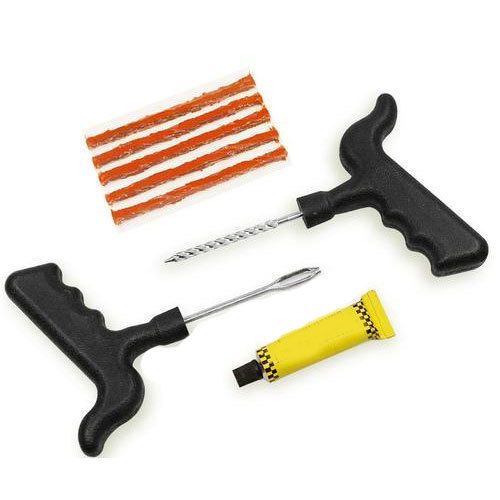
Do-it-yourself repair of tubeless tires is a simple task if you use a repair kit. The tire repair kit is a set of tools and accessories, among which you can find everything you need:
This simple tool kit allows you to quickly make minor repairs to your wheel after a puncture. You will spend about 10-15 minutes on the whole job. The repair kit, which includes a set of tools, harnesses and glue, is inexpensive. You will be able to repair a car tire yourself, without resorting to the help of a tow truck.
Do-it-yourself tubeless tire repair will save you money on services. Removing the nail from the wheel and sealing the resulting fistula is easy. It is advisable to watch a video of the work being done, which will allow you to get an idea of all stages of the repair. What are the steps for self-repairing a tire?
Removing the nail from the wheel and sealing the resulting fistula is easy. It is advisable to watch a video of the work being done, which will allow you to get an idea of all stages of the repair. What are the steps for self-repairing a tire?
One of the first tasks is to completely remove the sharp object from the tire rubber. This can be done with ordinary nippers. The repair kit does not have such a tool, but every driver in the garage can definitely find it. Why pull out the nail? Performing this stage of work will allow you to simplify the subsequent repair with a rasp and the application of a tourniquet to the puncture site.
To repair the puncture site, insert a tourniquet coated with adhesive. To do this, you need to prepare a hole in the rubber. Before removing a metal object from the tire, prepare a rasp. Apply glue from a tube to the metal pin of the tool. Only after that you can proceed to remove the nail or self-tapping screw.
One of the important points is the sequence of actions.
As soon as you pulled out the nail, you must immediately insert the rasp, which is included in the repair kit, into the resulting hole. This is necessary in order for the wheel to flatten.
After installing the tool on which the adhesive has been applied, a hole must be drilled. After watching a few videos, you can understand how best to do this. The ribbed surface of the metal base of the tool smoothes the edges of the hole in the rubber. How is the integrity of the tire restored? The harness, on which the glue is applied, is securely fixed to the rubber of the wheel, which leads to sealing of the breakdown. The video will allow you to visually consider the process of sealing a tire puncture with a tourniquet.
To seal your rubber, you need:
